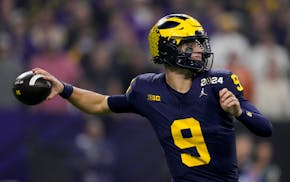It can be difficult to remember why the NCAA exists. So I checked. I went to NCAA.org, and the mission statement is right there, in white type on orange background:
"Creating a pathway to lifelong success.''
What could be better than that, other than a reverse mortgage that gives you whiter teeth in 30 days?
The problem is that the NCAA's pathway to lifelong success is a lot like highway travel in the era of nonstop construction in the Twin Cities. You may think taking 35W North will get you to your destination, because that's what it was designed to do. You would be wrong.
After this week, even the world's most sophisticated GPS would be confused by the NCAA's pathway.
On Wednesday, the NCAA informed the University of Minnesota that guard Marcus Carr would not be eligible to play basketball this season, denying Minnesota's appeal of the NCAA's initial decision.
Carr signed with Pitt and transferred after the coach who recruited him, Kevin Stallings, was fired.
Stallings received an estimated buyout of more than $9 million for failing to perform satisfactorily at his job. Carr faced the prospect of playing for a coach who did not recruit him and decided to transfer.
Carr is being punished for practicing the freedom of movement any other college student would take for granted, and for being one of the thousands of "student-athletes'' who make it possible for failed coaches to receive $9 million buyouts.
The NCAA has always been a broken, hypocritical organization. What's amazing is that it has never reformed itself, never made progress toward getting at least the small, obvious decisions right.
Who benefits from Carr sitting out a season?
No one.
Who is hurt by Carr being forced to sit out a season?
The Minnesota basketball program and Carr.
What did Minnesota do to deserve this?
Nothing.
What did Carr do to deserve this?
Nothing.
What is achieved by forcing Carr to sit out a season?
Nothing.
Making a random example of Carr, who has the same résumé as many athletes who were allowed to compete after transferring, does not set a precedent that will keep athletes from transferring in the future.
Nor should it. Athletes should be able to transfer freely, no matter how you view them.
If they are truly viewed as students first — which has always been the NCAA's winking stance — they should be able to transfer like any other students.
If they are viewed as valuable money-making athletes, they should be able to unionize, like other pro athletes, and collectively bargain their compensation and the rules governing their freedom to transfer.
The NCAA and the coaches, schools and athletic directors who get rich on the backs of the athletes have successfully muddled the argument by casting players as "student-athletes,'' a unique subset of the sports world in which the athletes who create ticket sales, television ratings and revenues have no employee rights.
Do they receive compensation? Yes. Scholarships are valuable. But they are a limited form of compensation.
Would you work for a company that paid you not in cash but in coupons? Even valuable coupons? No, because you can't take a coupon for a Caribbean cruise to Cub Foods.
The NCAA takes advantage of young athletes with limited options. And you've seen what athletes with options do — they leave the NCAA as quickly as possible to go pro.
Most organizations with the NCAA's unconscionable history would try to avoid creating stories that remind the public of that history. In this case, all the NCAA had to do was let a kid play basketball after transferring from a program that fired the coach who recruited him.
This wasn't a tough one, unless you're a backward and illogical organization like the NCAA.
Jim Souhan's podcast can be heard at TalkNorth.com. On Twitter: @SouhanStrib. jsouhan@startribune.com

Souhan: Wolves fans made Game 1 special. Now bring on Game 2.

Souhan: Should Vikings even consider McCarthy in NFL draft?

Souhan: NAW erases Suns' lead, Game 1 advantage with big performance

Souhan: This is KAT's chance to prove Flip Saunders was right

